Let’s get in the hot tub time machine, back to when conventions were fun and convention program books weren’t 90% ads! Let’s bubble back to Bay Con 1, in 1975!
Bay Con 1 program book, 1975
Tom Orzechowski, editor
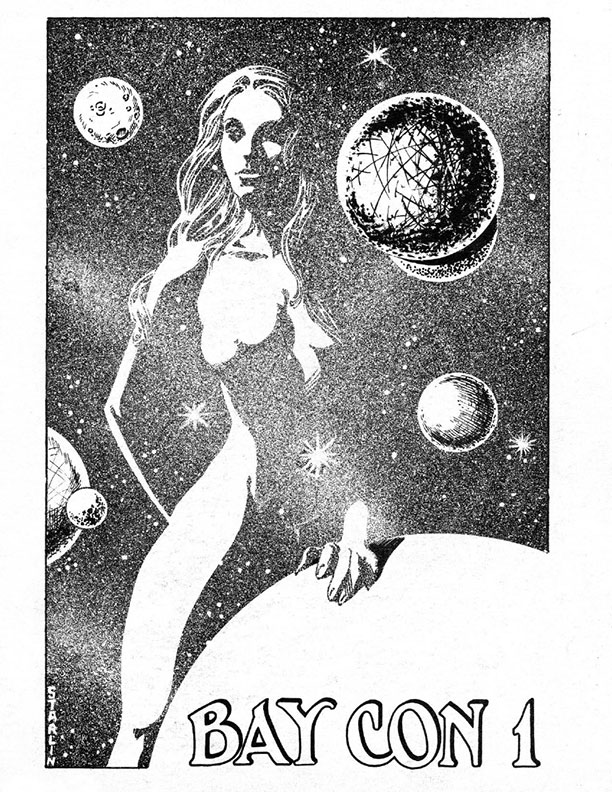 Comic conventions these days, especially the big ones, are often impersonal, over commercialized affairs where you can get lost, get exhausted, get hosed, and still not get satisfied. But, there used to be a time when this was not true. Comic conventions used to be informal gatherings where creators and fans could fraternize without bodyguards and autograph charges. Honest!
Comic conventions these days, especially the big ones, are often impersonal, over commercialized affairs where you can get lost, get exhausted, get hosed, and still not get satisfied. But, there used to be a time when this was not true. Comic conventions used to be informal gatherings where creators and fans could fraternize without bodyguards and autograph charges. Honest!
Though the entry for this installment is not a fanzine per se, it’s close enough. The program book for the first Bay Con (I thought there was only one, but Tom Orzechowski tells me there was a second, more on that later) certainly looks like a fanzine in its appearance. It is filled with great art from pros and a few fans, has a few columns, and given its rarity, deserves coverage in this column.
This convention book is also very much of its time, both visually and thematically. Professional comics were going through a real “cosmic” phase. None represented this better than the “King of Kosmic,” Captain Marvel, Dreadstar, and Warlock creator/revamp specialist Jim Starlin, with his cover seen at top. Created long before you could apply a filter in photoshop to achieve the starry starry night in this illustration, Starlin most likely physically masked off the white areas of the figure and planets, then used a toothbrush to apply all those white stars. Starlin was also connected to the “ground level” independent comic Star*Reach, and many other contributors of that comic make appearances in this mag. Underground comics were also still being published, and San Francisco was the headquarters of this cottage industry. The illustration by Tim Bird shown below pokes fun at this battle for readers being fought between the two related, but separate industries.
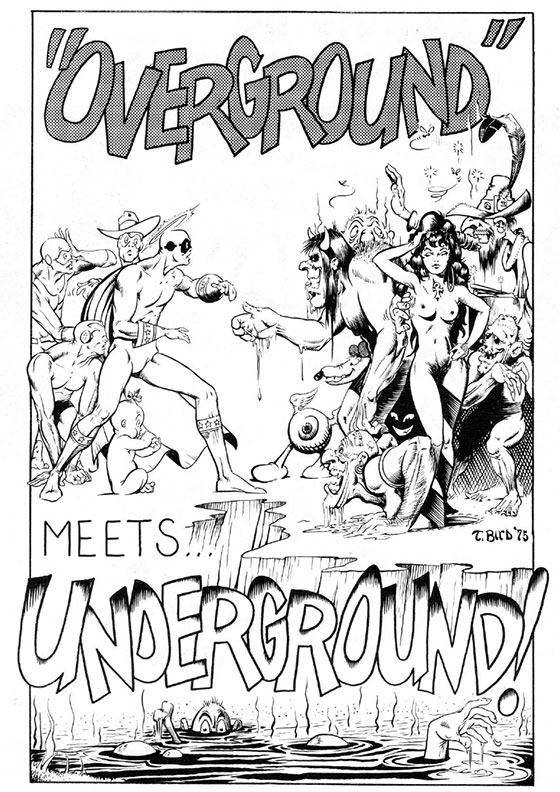
Of course there were creators that moved back and forth between these two variations of the comic book publishing world, but there weren’t very many. Most of the underground artists and writers were either considered not good enough for mainstream comics, or just too hard to control. From all indications, those same underground creators most likely wouldn’t work at Marvel under any circumstances anyway, as the freedom of content they had in the underground would have been strangulated by the comics’ code in “the world above.” One of the seminal underground artist/writers was Vaughn Bode, who contributed the Cheech Wizard piece below. You can explore his site here. Sadly, the same year this convention was held, Bode died under suspicious circumstances.
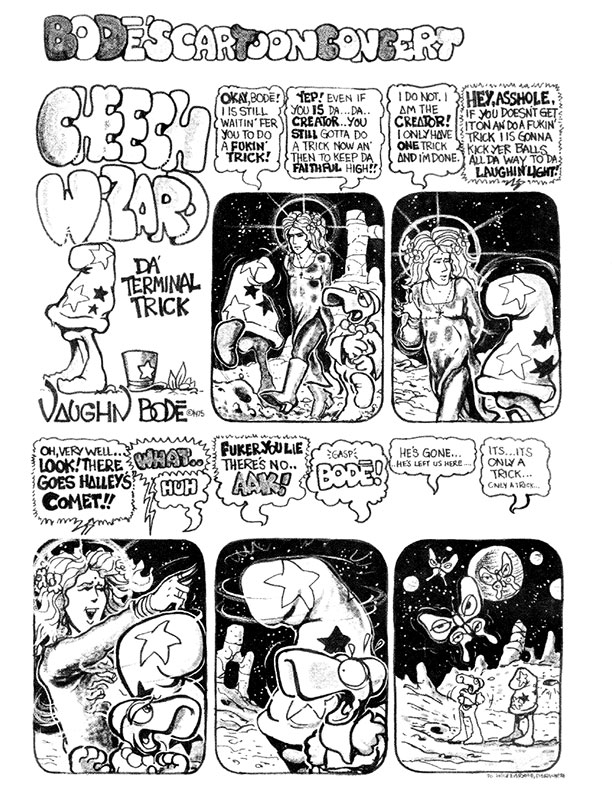
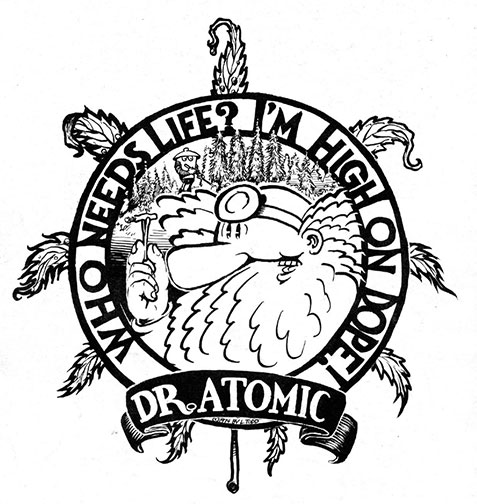 Several other underground talents show up in this program book, including Paul Mavrides, and Larry Todd, who contributed the back cover illustration at left of his well known toker, Dr. Atomic.
Several other underground talents show up in this program book, including Paul Mavrides, and Larry Todd, who contributed the back cover illustration at left of his well known toker, Dr. Atomic.
The “ground level” crew at Star*Reach are well represented here, as well. It might have helped that super duper lettering pro Tom Orzechowski was in charge of “publications” for the convention. Tom himself showed some variations on his well known Howard the Duck logo seen a few paragraphs below.
Amongst the Star*Reach group was a subset of artists/writers from the fanzine Venture, including Brent Anderson, Frank Cirocco, and Gary Winnick. You can see a few of their contributions below. Another untimely death the year of 1975 was Bruce Lee, whom Brent Anderson paid tribute to immediately below. More Lee later.
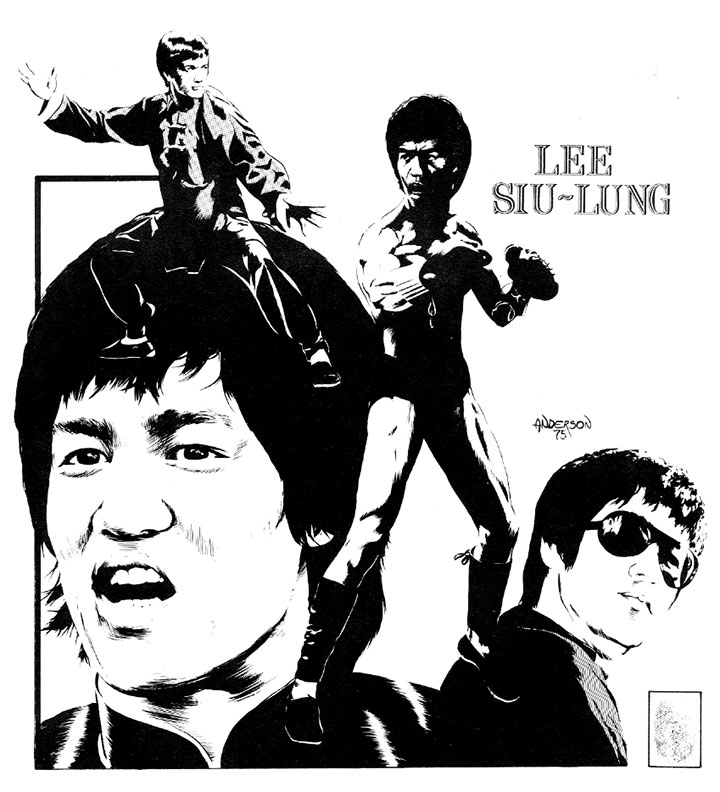

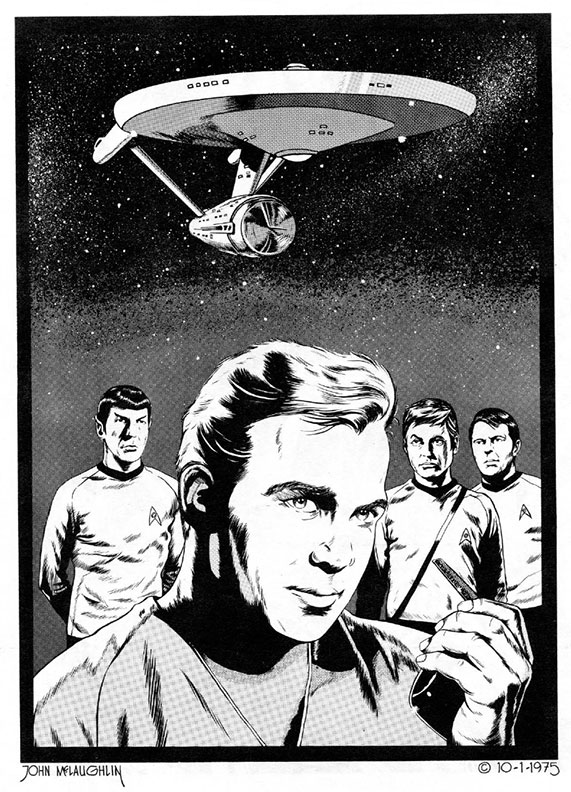
All three creators were instrumental in the formation of this program book, along with Orzechowski, Jim Pinkoski, and John McLaughlin, John represented immediately above. Tom imparted a wealth of inside info and anecdotes via facebook that will illuminate and entertain below:
Bay Con was a comics con for only a few years before it became a science fiction con in ’81. Were you part of the original 1975 organizing committee?
I came into it pretty early. I was living in Berkeley then,  and had been doing lettering for a couple of years for Marvel and elsewhere. A guy named John Watson came by one day to ask if I’d be a guest. He belonged to a comics buying cooperative, and they felt that there were so many comics pros in the area that a con would be a good bet. Well, John and I hit it off immediately, and I’d already had some con committee experience, so I took on the job of ads and publications. Pretty soon I was also the pro liaison, because I knew people who knew people. After all that, when it came time for the con itself, I’m not sure I actually functioned as a guest.
and had been doing lettering for a couple of years for Marvel and elsewhere. A guy named John Watson came by one day to ask if I’d be a guest. He belonged to a comics buying cooperative, and they felt that there were so many comics pros in the area that a con would be a good bet. Well, John and I hit it off immediately, and I’d already had some con committee experience, so I took on the job of ads and publications. Pretty soon I was also the pro liaison, because I knew people who knew people. After all that, when it came time for the con itself, I’m not sure I actually functioned as a guest.
How soon after this convention did Vaughn Bode die? I think it was the same year, correct? Did you have much interaction with him? Along the same lines, I couldn’t find any info on Vincent Bode, who I assume is Vaughn’s brother. Did he do much cartooning himself?
Vaughn didn’t attend in ’75, but his brother Vincent did the cartoon concert. This was a less than dramatic reading of Vaughn’s character dialogue set to a slide show of Vaughn’s comics, panel by panel, and Vaughn did it for a few year at different conventions. For us, Vincent did it as a tag-team with another of our guests, Brian Narelle. Brian was in the cast of an indie sci-fi film called Dark Star that won a Best Special Effects award. The film, incidentally, also starred Dan O’Bannon, who wrote it, and later co-wrote the classic film Alien. Vincent did some cartooning at the time, but moved into fine art.
I am not familiar with quite a few of the artists. Did they work mostly in the undergrounds?
Not everyone. There were some local mainstream-leaning artists… Brent Anderson, Frank Cirocco, John McLaughlin, Jim Pinkowski Gary Winnick, Carl Potts and Tony Salmons. And you. Most of you moved to New York within a couple of years and started getting great gigs almost immediately. And then, of course, there were the Marvel people who moved to the Bay Area at around the same time I did: Jim Starlin, Steve Englehart, Frank Brunner and Alan Weiss.
A lot of the others had solid credits but weren’t in the first set of underground artists, so their names don’t resonate. On weekends, Watson and I traveled all over town, meeting these great people and collecting all of this incredible artwork. Larry Rippee had a solid sense of ‘20s-‘50s comic strips, and did pages for a lot of anthologies. Becky Wilson did only a bit of comics work, mostly for the Wimmens’ Comics collective. Otherwise, she worked in graphics and publication design. Paul Mavrides scripted and inked Freak Brothers, and did illos for the Church of the Sub-Genius. Jay Kinney did stories for some of the earliest undergrounds, including Young Lust and Bijou Funnies. Barry Siegel & Bruce Simon did some self-published issues and some magazine work, a lot of which I lettered. Sharon Rudahl was in some anthology comics, and did some single issues for Kitchen Sink Press, as did Lee Marrs, who was also published by Star*Reach. I don’t remember anything about Tim Bird. Finally, there’s Larry Todd, who was in a lot of anthology titles, and did a few issues of Dr. Atomic Comics. Larry was also good friends with Vaughn Bode, and brought that sensibility to the con.
All of the local Marvel artists came through for you, it looks like.
That was the easiest part, since we were all in fairly close touch right then. Jim Starlin and Steve Leialoha, yeah, I worked with them all the time then. The con was intended as a midway point between mainstream comics and the undergrounds, so the program book is all over the place. The Bay Con Pig that introduces the book was by Carl Lundgren and Greg Theakston, a couple of commercial artists I met in Detroit. Carl had done posters for Detroit’s late ‘60s music venues before moving into book covers. Greg had assisted Jim Steranko before joining Neal Adams’ crew of inkers. Frank Hill drew the Short Ribs and Bugs Bunny comic strips. Leslie Cabarga didn’t do any comics, but at that time he was doing ‘30s style pieces like this cover for Marvel’s short-lived underground style mag Comix Book, as well as Deco-influenced commercial work. Alan Kupperberg was a cartoonist for National Lampoon and elsewhere. Don Rico should have been better known, since he’d worked on Daredevil in the early ‘40s, and then for Timely/Atlas/Marvel afterward. Jack Katz had credits back to Fawcett in ’43 and then everywhere else for another 30 years, before launching his key work, The First Kingdom. Terry Austin and I knew each other in our fan days, and he was a pal to send me a piece that he inked over his own pencils. He was assisting Dick Giordano in those days.
The Brunner centerfold, was that done as a collage by you guys, Brunner himself, or redraws of various existing pieces?
You had it right the second time. Frank assembled that one himself from copies of his inked pages. Between Doctor Strange, and suddenly Howard the Duck, he was riding very high at that moment.
The Howard logos you show, were those sketches before the final one, variations on the logo for other iterations, or what?
Those were my submission sketches. Marvel went instead with one that looked like a Marvel logo. I never was a perfect fit with them. The chief editor there once mentioned to me that my work looked too much like underground comics. What can I say? I also went for that ‘20s-‘50s look.
What is the significance of the Charles Biscuit Band art?
They were friends of Larry Todd’s, and played at the con. That’s Larry’s illo.
Any chance you remember who did what on that piece that is an ad for Cymbaline Records and the other store? Was it an actual jam piece done for the con?
Frank penciled the duck and probably the skull; Jim drew the facial feature creature; Scott Bell, a friend of Alan Weiss’, drew the banana critter. Englehart probably drew the moon. Alan penciled the gal, “smegma,” added the dialogue, and inked the whole page. And yes, it was done for the con, probably at Alan’s house.
 Why did Bay Con become a science fiction con?
Why did Bay Con become a science fiction con?
After two years, John and I had had enough of giving up our weekends. A third comics-style Bay Con was handled by a different comics dealer, after which I moved back to New York. I believe that a World Science Fiction Con was then held in San Francisco under the name Baycon, entirely unconnected to the comics cons. From there, the name was adopted by an unrelated science-fiction con based in San Jose. We used Bay Con as two words for our two years, but it’s been just one word ever since.
A few more cohorts of the Venture crew chime in with some beautiful full page illustrations. Carl Potts, with some help from Brent Anderson, is below, while Tony Salmons’s wonderfully airy tragedy in space photo op is above left.
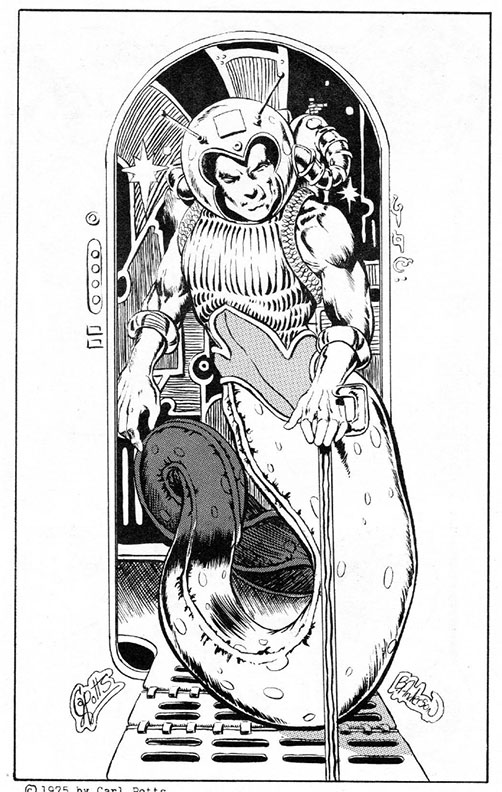
Now, the “above ground” professionals had their part in this program book, as well. Two big names, one from each of the big two, are represented, John Romita and Joe Kubert.

 Relatively new pro Berni Wrightson is also present…well, at least for a few panels, as you will see above (one of two pages). I guess we can see now why Berni never had any trouble accessing the dark side.
Relatively new pro Berni Wrightson is also present…well, at least for a few panels, as you will see above (one of two pages). I guess we can see now why Berni never had any trouble accessing the dark side.
Damn, but that Berni can draw hands well, can’t he? Well, I can contain myself no longer. This program book, along with the help (and inking) of Brent Anderson, allowed me my first published work! Before any other fanzine illustrations (and there were many), the Bruce Lee illustration you see below was printed. And it was a huge deal for me, even though I never got to attend the con. I was a lowly high school student in a small town in Utah, far, far away from the underground headquarters of the bay area. So, without further a doo-doo….
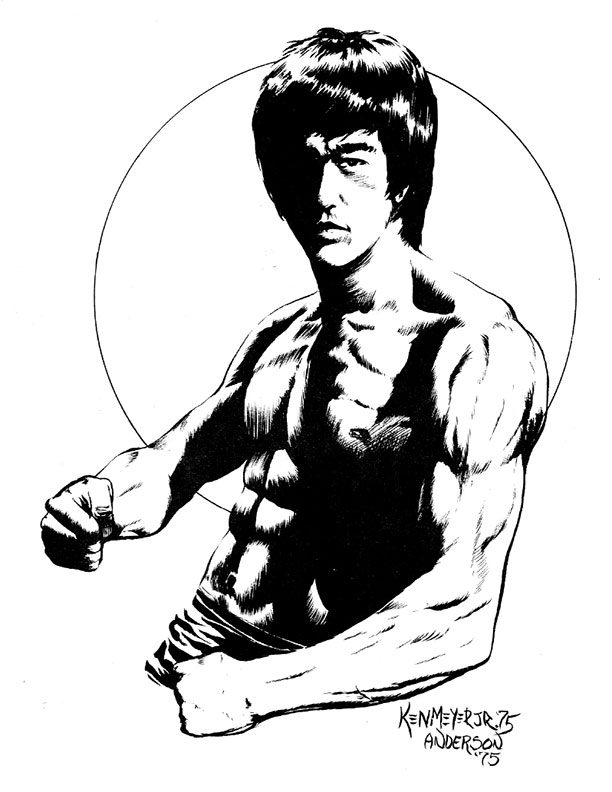
There are many other very nice illustrations in this chronicle of times gone by, but I will save some for the pdf. For now, see an understated piece from Jay Kinney, below.
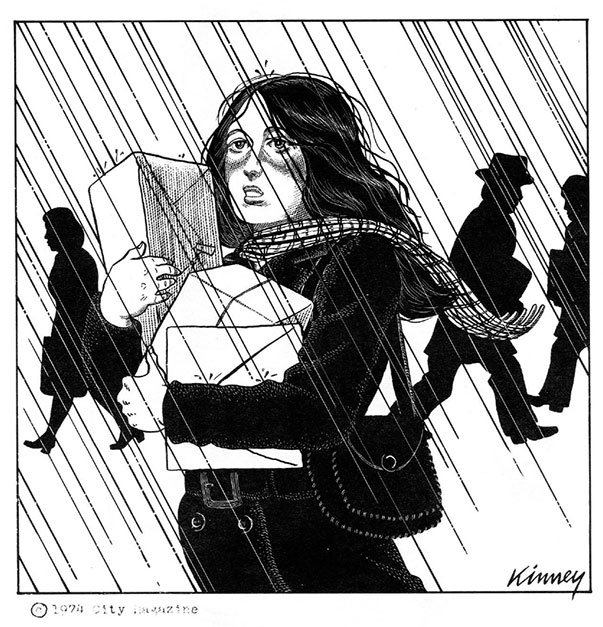
Kinney moved out of cartooning eventually and into writing books and editing magazines. You can see his very well done site here. Steve Leialoha became a pro at the aforementioned Star*Reach productions, but also did a ton of work (mostly inking) for Marvel and DC. He still lives in San Francisco with his fellow cartoonist, Trina Robbins (a mainstay of undergrounds and Star*Reach, especially those dealing with women’s rights and issues).
Thanks this time go out to Tom Orzechowski, who answered several questions and supplied some information on his own. Remember, in the pdf, you get the whole publication…and there is so much more work to see!
I hope you have enjoyed your journey back into a time when cons were fun, informal, but still filled with incredibly talented people…people you could actually meet and have a relaxed conversation with! This convention and this convention book (though professionally produced) is indicative of the laid back nature of the San Francisco bay area. It makes you want to go back in time, hop a trolley, and check out a head shop or two. As Styx said, light up!
Ken Meyer Jr.
kenmeyerjr@yahoo.com




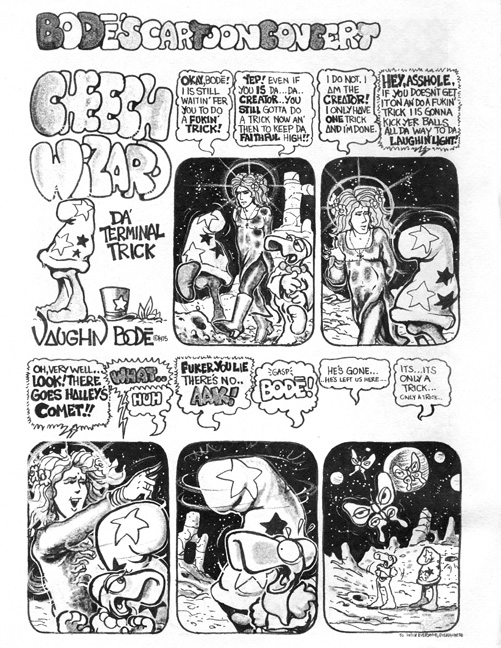

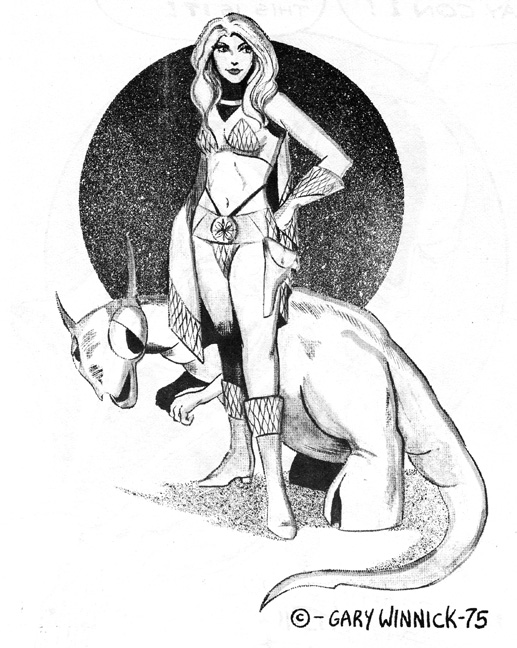




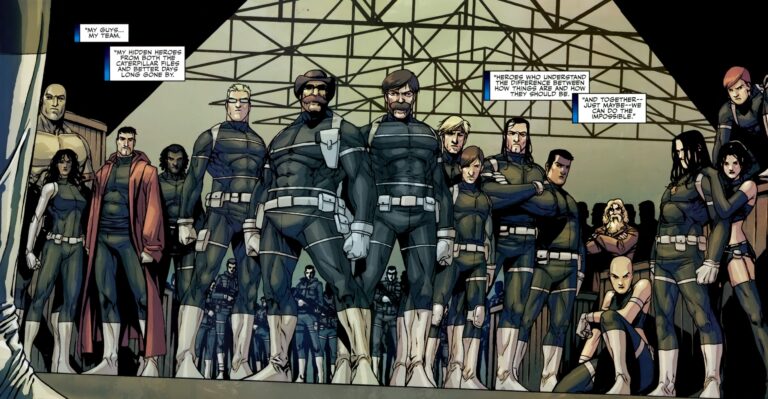
Haha, that Conan pic is great! I really like that one with the young girl in the rain as well.
This is a great example of an early con book/fanzine. The reason it’s so much like a fanzine is because fanzines were so huge during that time period, they influenced everyone and everything. The earliest issues of “The Buyer’s Guide for Comic Fandom” featured many prominent fanzine ads — including many full-page ads.
Love the Bruce Lee illo. Did every young comic book artist in 1975 draw Bruce Lee? I know I did!
Speaking of those early conventions, remember when what films were going to be screened was a major draw at conventions? I remember going to a con specifically to see all the Planet of the Apes films screened back-to-back-to-back. There was no other way to see serials, old films, cartoons, film shorts or old TV shows except at the rare art house theatrical showing (say, a Three Stooges film festival), or at a comic book convention.
Not any more!
Thanks for stopping by, guys! Russ, I actually did a really big Bruce Lee poster too (you can see it on my website…I think in the bio section)…I was hugely into him back around that time.
I dig the KMJ original!
; )
Thanks, Andy!
Just stumbled across your piece on the early Bay Con and thoroughly enjoyed the trip down memory lane. Tom and I spent many late nights and long weekends on the first two Bay Cons and it was a complete labor of love as the only thing we got back from those long hours were a ton of memories and some long lasting friendships. My goal was to make enough money to pay all the con bills and maybe have a little left over to start the ball rolling for next year’s show. As I recall the print run on the Bay Con 1 program book was only around 2000 as we had no concrete idea of what the attendance would be and money was extremely tight. I still have several of the originals hanging on my wall, along with quite a few nice sketches that were done for me during the show. You did a bang up job in your article in capturing the spirit and intent of those early cons. Kudos!!!
Pingback: Ink Stains 52: MCR 4 – ComicAttack.net